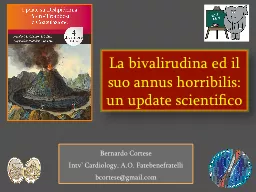PPT-La bivalirudina ed il
Author : alone2cute | Published Date : 2020-10-01
suo annus horribilis un update scientifico Bernardo Cortese Intv Cardiology AO Fatebenefratelli bcortesegmailcom HORIZONS AMI 30 Day and 1Year AllCause
Presentation Embed Code
Download Presentation
Download Presentation The PPT/PDF document "La bivalirudina ed il" is the property of its rightful owner. Permission is granted to download and print the materials on this website for personal, non-commercial use only, and to display it on your personal computer provided you do not modify the materials and that you retain all copyright notices contained in the materials. By downloading content from our website, you accept the terms of this agreement.
La bivalirudina ed il: Transcript
Download Rules Of Document
"La bivalirudina ed il"The content belongs to its owner. You may download and print it for personal use, without modification, and keep all copyright notices. By downloading, you agree to these terms.
Related Documents

